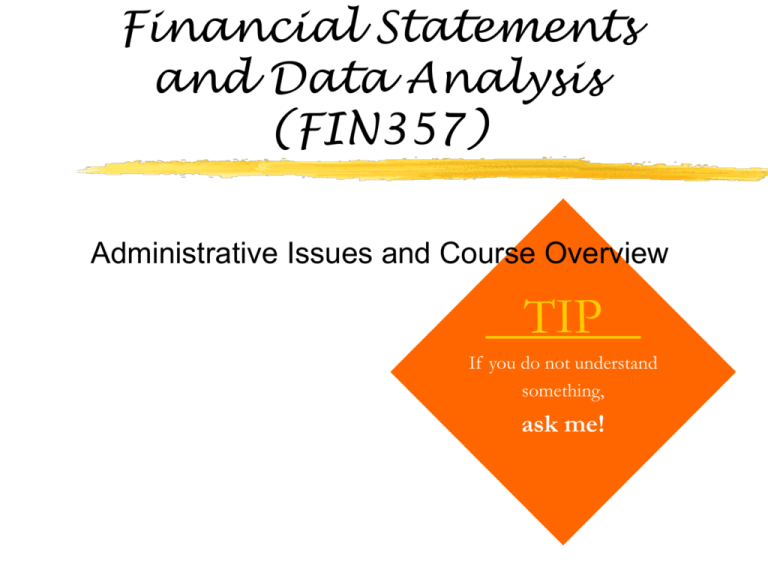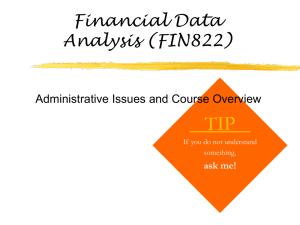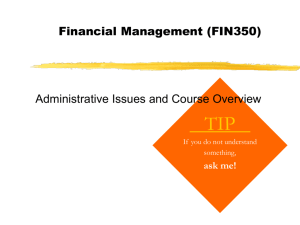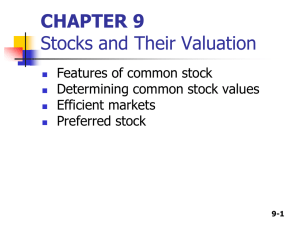
Financial Statements
and Data Analysis
(FIN357)
Administrative Issues and Course Overview
TIP
If you do not understand
something,
ask me!
The instructor
My name is Donglin Li.
Email: donglinli2006@yahoo.com,
donglin@sfsu.edu
)
or
Office hours: Mon 14:00-17:00, Tu 13:00-14:00, Bus 315
http://online.sfsu.edu/~donglin/courses.html
Research interest:
Corporate finance: Agency cost, overinvestment
Accounting: Financial Statement Analysis, Market
Anomalies
Credit Risk Analysis
2
My expectation in this course
I want everyone in the room to be able
to
understand fundamental financial statements
identify potential areas of earnings
manipulation and earnings management and
make necessary adjustments
carry out basic valuation analysis and credit
analysis
master a set of statistical tools that will help
you identify the relation between some
accounting variables/ratios and stock returns.
3
My experience
students who come to classes, listen, do
problems, do projects, take tests, review the
issues, and think, usually do well.
students who do not come to classes
typically do poorly.
4
Textbooks
“Financial Statement Analysis: A Global
Perspective” By Robinson, Munter, and
Grant, Pearson/Prentice Hall.
5
Prerequisite
FIN350 with a grade of C- or better and
ISYS 263 or pass computer information
system proficiency test.
In addition, you should have a good
knowledge of financial accounting and
statistics.
6
For the 2nd half course,
you may use any statistics/econometrics
textbook that you are familiar with. The
textbook should cover regression analysis.
“Analysis of Financial Data”, By Gary Koop, John Wiley
“Introductory Econometrics with Applications” By Ramanathan, 5e,
South-Western.
7
Add, drop and withdrawal policy
The business school has the policy for
add, drop and withdrawal
In the first four weeks, you have to get
enrolled in the class, if you want.
Students can withdraw at most once.
8
Homework
The best way to learn new concepts is to
work through some problems. The
solution will be posted on my web.
I will also put lecture slides and in-classwork on my web.
9
Projects
You need to work independently on the 2
projects.
You need to have access to a PC.
10
In-Class-Work
There will be 5 in-class work assignments.
The 2 lowest in-class-work scores will be
dropped.
The schedule of these in-class projects will
not be announced in advance, so just
come to the lectures.
11
The quizzes and final exam
The quizzes are closed-book. There are no
make-ups.
The tests are based on material covered in
lectures, in-class-work, homework, and
textbooks.
The in-class-work will be relevant for
the quizzes; The quizzes will be relevant
for the final!
12
Class performance
Any attempt to seek favor from the
instructor will negatively affect your class
performance.
The instructor cannot assign extra work to
any individual to improve her/his grade.
13
Grading
Your available total points will be allocated
in the following way:
Class performance
9%
Projects
15%
In class work
15% (drop 2 lowest)
Quizzes
36% (drop 1 lowest)
Final
25%
14
Curve grade
A range Top 15%
B range Top 55%
C range Top 80%
D range Top 90%
F
Bottom 10%
The instructor
reserves the right to
make minor
adjustment if
necessary.
15
Academic integrity
The instructor has zero tolerance for
cheating or looking at each other during
the exams.
In the exams, please sit as far as possible
from each other.
In doing the in-class-work, feel free to
discuss with your classmates.
16
Communicate with the
instructor
Teaching Style: Lectures and problem solving.
Please pay attention to what is covered in class.
The textbook may contain more material than
required.
I APPRECIATE any constructive suggestions (in
person or through email) that would improve
the course. The teaching contents could be
modified in response to your inputs.
17
Course organization
This course is broken-down into two parts:
1: Financial Statements Analysis (analyzing
one firm or comparing a few firms: a worm’s
view.)
2: Data Analysis (analyzing a lot of firm’s
financials at the same time: a bird’s view.)
18
Why are financial statements
important? (1st part of our course)
Managers use them to monitor and judge firm
performance, acquire other businesses.
Financial analysts use financial statements to rate
and value companies.
External investors read financial statements to
select stocks and decide when to buy or sell.
Bankers use them in deciding whether to extend
loans and determine loan terms.
19
In this course, we emphasize the
perspective of a financial analyst:
Understanding clean financial statements
Identify questionable areas of earnings
management
Identify questionable areas of earnings
manipulation
Make necessary adjustments
Put your restated inputs into the frameworks for
equity valuation and credit analysis.
20
Why do we need to make adjustments
on financial statements?
Earnings manipulation
GAAP
Earnings management
Real earnings management
No earnings management
21
Equity Valuation Analysis
Discounted cashflow models
Residual income model
22
Credit Analysis
Z-scores
Z=1.2 Net Working Capital/Total assets+1.4 Retained
Earnings/Total assets+3.3 EBIT/Total assets +0.6
Market Value of Equity/Book Value of Liability+1.0
Sales/Total assets
( Z<1.8 indicates significant bankruptcy risk)
Other models
23
We do not emphasize
accounting rules.
A basic knowledge of rules and standards
is ok.
24
Why is Data Analysis useful?(2nd
part of course)
Because you do not believe in semi-strong
form of market efficiency.
Because you can identify variables/ratios
that might be relied upon to predict future
stock returns.
Earn huge bucks!
Another eye-catching item on your
resume.
25
Combining financial statement
analysis and data analysis
After identifying several stocks from data
analysis, you can apply financial
statement analysis to distinguish which
one is most attractive.
26
In Data Analysis,
We will focus on regression techniques.
Example, is there a significant relation
between firm investment and future stock
returns?
27
One-year-ahead hedge returns based on capital
investment levels. ©Donglin Li 2004
1 year ahead hedge returns between lowest and highest deciles of investment (d_PPE) firms
Go long the lowest investment
stocks.
0.35
Go short the highest investment
stocks.
0.3
0.25
12 month size adjusted buy and
hold hedge returns after May each
year.
Hedge Portfolio Return
0.2
0.15
Positive in 36 out of 39 years,
average 12.6%
0.1
0.05
0
1962 1964 1966 1968 1970 1972 1974 1976 1978 1980 1982 1984 1986 1988 1990 1992 1994 1996 1998 2000
-0.05
-0.1
Pattern is consistent with
market mispricing and
inconsistent with semistrong efficiency.
Year
28
Congratulations on enrolling
this exciting (and challenging)
course!
29








